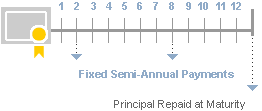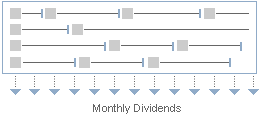Bonds Vs Bond Funds an Easy Choice
There's no definitive right or wrong answer here; there are pros and cons both to buying individual bonds or buying a mutual fund that invests in bonds. In some cases, it makes the most sense to combine individual bonds with bond mutual funds. A right choice for you depends on your ability and interest in researching your initial investments, your willingness to track them on an ongoing basis, the amount of money you have to invest, and your tolerance for different types of risk.
Individual bonds
A distinguishing feature of individual bonds is their commitment to pay out a defined amount of income at regular intervals, usually twice a year. This income is generally expressed through the coupon—which in most cases is fixed. The bond's principal is returned to you when the bonds mature.

Another key differentiator of individual bonds is that they give you the ability to buy into a fixed rate of return, or "yield," at the time of purchase. By calculating the future cash flows—based on the bond's coupon and principal—as a function of the purchase price, it is possible to derive a total return or yield to maturity—or yield to call in the case of callable bonds. This yield is the annual return on your initial investment through some predetermined future date. Remember, achieving this calculated yield rests on 2 important assumptions:
a) You hold the bond until it either matures or is called.
b) The issuer does not default so that you receive all interest payments and your principal.
Note that interest and principal payments are subject to the issuer's creditworthiness, and a higher quoted yield frequently implies a higher risk of the bond defaulting and thus not delivering on its promised cash flow and yield.
As an investor, it's important to remember that while investing in individual bonds and holding them until maturity or the call date enables you to effectively manage interest rate or market risk, it does heighten the importance of scrutinizing credit risk of each individual issuer while carefully assessing your own liquidity needs.
You can sell individual bonds before the maturity date, although certain bond types that trade in more liquid markets—such as Treasuries and certain corporate bonds—may be easier to sell than most municipal bonds, where markets are thinner and less liquid. Selling before maturity can result in either a profit or a loss, depending on the price you paid for the bonds, the amount of interest you've already collected, the current interest rate environment, and the current price of the bonds.
Investing in individual bonds will require sufficient funds to enable you to diversify across several different issuers to ensure a reasonable amount of diversification. When investing in bonds that contain credit risk such as corporate bonds or municipal bonds, Fidelity recommends you have at least several hundred thousand dollars allocated to the fixed income portion of your portfolio, across multiple issuers, in order to diversify in the face of credit risk. At the other end of the risk spectrum, if you're buying Treasury bonds or brokered CDs which have historically been the safest fixed income instruments available, you can invest as little as $1,000. With US Treasuries, your investment is backed by the full faith and credit of the US government. In the case of CDs (at least the brokered CDs that Fidelity offers), your investment principal is covered under the FDIC insurance program providing your investment remains under the FDIC insurance limit (currently set at $250,000 in aggregate deposits, per issuer, per account type).
Buying individual bonds also means you're responsible for researching and monitoring the financial stability of the issuer, determining if the bond price is reasonable, and building a portfolio around your need for income, risk tolerance, and general diversification. Fidelity can help you do this, through our Fixed Income Research Center and Monitoring Alerts.
Bond funds
Bond mutual funds are just like stock mutual funds in that you put your money into a pool with other investors, and a professional invests that pool of money according to what he or she thinks the best opportunities are, in accordance with the fund's stated investment goals.

Some bond funds seek to mimic the broad market, investing in short- and long-term bonds from a variety of issuers, such as the US government, government agencies, corporations, and other more specialized securities. Other bond funds focus on a narrower mix of bonds, such as a short-term Treasury fund or a corporate high yield fund.
Whether the fund's mandate is broad or narrow, bond funds invest in many different securities, so it's an easier way to achieve diversification even with a small investment. Income payments are made monthly, and reflect the mix of all the different bonds in the fund and the payment schedule of each. As such, the distribution will likely vary from month to month.
When you sell shares in a fund, you receive the fund's current net asset value (NAV), which is the value of all the fund's holdings divided by the number of fund shares, less any redemption fee, if applicable. It's important to remember that bond funds buy and sell securities frequently, and rarely hold bonds to maturity. That means you can lose some or all of your initial investment in a bond fund.
A quick comparison
| Individual bonds | Bond funds | |
|---|---|---|
| Management | Investor managed or professionally managed via a managed account of individual bonds | Professionally managed |
| Maturity date | Set maturity date (though some bonds may be called prior to maturity) |
|
| Income payments | Usually a fixed semi-annual income payment, some bond income is monthly or quarterly | Fluctuating monthly income distributions |
| Market risk |
| Market conditions constantly affect the fund's value, although the diversification inherent in a fund generally reduces the market risk of any one bond issuer. When you redeem shares of a fund, the sale may result in a capital gain or loss. |
| Liquidity | You can generally buy and sell a bond prior to maturity on the secondary market. Some bonds are more liquid (trade more frequently) than others: US Treasuries are generally the most liquid, while small municipal issues are generally much less so. A lack of liquidity can result in price volatility, especially in a period of market or issuer-specific stress. In some cases liquidity can disappear altogether for indefinite periods. | Investors can generally buy and sell fund shares at any time, at the current market value (or NAV) of the fund. The NAV is calculated at the close of every business day and any fund purchases and sales are processed overnight at the NAV calculated for the most recent trading day. Some funds may carry a redemption fee. |
| Diversification | Investor must purchase many bonds from multiple issuers and maturities to achieve diversification—which means it may require a significant investment to achieve diversification. | Bond funds invest in many individual securities, providing diversification for a relatively small investment minimum. |
| Credit risk | Higher-rated bonds historically have a lower risk of default. |
|
| Cost | A mark-up or mark-down upon purchase or sale. The mark-up/mark-down is the difference between the dealer's purchase price and its subsequent sales price to a customer. If the bonds are part of a managed account program, then the investor pays an annual advisory fee. |
|
Next steps to consider
![]() close
close
Your e-mail has been sent.
Source: https://www.fidelity.com/learning-center/investment-products/mutual-funds/bond-vs-bond-funds
0 Response to "Bonds Vs Bond Funds an Easy Choice"
Post a Comment